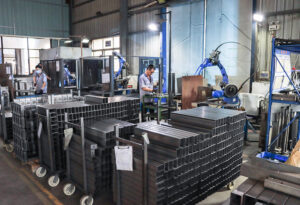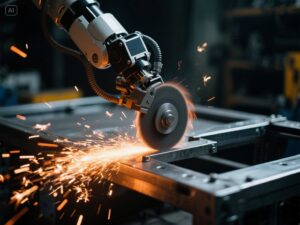Introduction
The modern workplace is transforming, with a significant shift towards health-conscious and productivity-enhancing solutions. One such innovation is the adjustable standing desk, which has gained popularity for its ability to combat the health risks associated with prolonged sitting. These desks offer a dynamic workspace, allowing users to alternate between sitting and standing throughout the day, thus promoting better posture and increased physical activity. As the demand for such ergonomic solutions surges, the necessity for factories to efficiently mass-produce adjustable standing desks becomes evident. This article delves into the intricacies of manufacturing these desks at scale, highlighting the key considerations and strategies for success.
Market Research and Demand Analysis

Understanding the Market
In the competitive landscape of office furniture, market research is crucial for identifying the needs and preferences of the target demographic. Understanding the market involves analyzing current trends, gauging the potential for growth in the adjustable standing desk sector, and identifying the specific pain points that these desks can address. This research should encompass surveys, focus groups, and data analysis to understand the market’s demands comprehensively.
Competitor Analysis
To stand out in the market, it’s imperative to analyze the competition. This involves studying the features, pricing, and marketing strategies of existing products. By identifying market gaps and differentiation opportunities, manufacturers can tailor their offerings to meet unmet needs. For instance, if competitors lack in customizable features, a factory might focus on producing desks with a wide range of adjustable settings. Understanding the competition not only helps in positioning the product but also in identifying potential collaborations or areas for improvement.
Product Design and Development
Ergonomics in Design
 The design of an adjustable standing desk must prioritize ergonomics to ensure user comfort and reduce the risk of injury. This involves considering the range of motion required for a user to transition from sitting to standing, the desk’s stability at various heights, and the ease of adjustment mechanisms. Ergonomic principles should guide the design to accommodate users of different heights and physical abilities, promoting inclusivity and accessibility.
The design of an adjustable standing desk must prioritize ergonomics to ensure user comfort and reduce the risk of injury. This involves considering the range of motion required for a user to transition from sitting to standing, the desk’s stability at various heights, and the ease of adjustment mechanisms. Ergonomic principles should guide the design to accommodate users of different heights and physical abilities, promoting inclusivity and accessibility.
Design Process
The product design process begins with conceptual sketches and evolves through multiple iterations to a functional prototype. Each stage involves input from designers, engineers, and potential users to refine the desk’s form and function. Prototyping allows for hands-on testing of the desk’s mechanics, ensuring that the height adjustment is smooth and the desk remains stable under load. This iterative process is critical in identifying and addressing any design flaws before full-scale production begins.
Design Flexibility
In a market with diverse needs, flexibility in design is key. This can be achieved by creating modular components that can be easily swapped or adjusted to suit different workspaces or user preferences. For example, a desk might offer a range of tabletop materials, cable management solutions, or Additional features. Such flexibility not only caters to a broader customer base but also future-proofs the product against changing trends and requirements. Designing with flexibility in mind allows manufacturers to pivot quickly to meet emerging Market demand while maintaining a consistent brand identity and product quality.
Selecting the Right Materials and Suppliers
Material Considerations
 The choice of materials for adjustable standing desks is paramount, as they directly impact the product’s durability, sustainability, and safety. High-quality materials not only ensure the desk’s longevity but also contribute to the overall user experience. Manufacturers should opt for robust materials that can withstand frequent adjustments and support the weight of various office equipment. Additionally, the environmental impact of materials must be considered, with a preference for those that are recyclable or sourced from sustainable practices.
The choice of materials for adjustable standing desks is paramount, as they directly impact the product’s durability, sustainability, and safety. High-quality materials not only ensure the desk’s longevity but also contribute to the overall user experience. Manufacturers should opt for robust materials that can withstand frequent adjustments and support the weight of various office equipment. Additionally, the environmental impact of materials must be considered, with a preference for those that are recyclable or sourced from sustainable practices.
Supplier Evaluation
Selecting reliable suppliers is a critical step in the production process. This process begins with a thorough evaluation of potential suppliers based on their ability to meet quality standards, delivery timelines, and competitive pricing. Suppliers should be vetted for their environmental practices, labor standards, and compliance with industry regulations. Long-term partnerships with suppliers can lead to cost savings, consistent material quality, and a streamlined supply chain. Regular audits and communication are essential to maintaining strong supplier relationships and ensuring that materials meet the factory’s stringent requirements.
Production Process Planning
Production Workflow
 The production workflow for adjustable standing desks must be meticulously planned to optimize efficiency and quality. This begins with the cutting and shaping of raw materials, followed by the assembly of desk components, which includes the integration of mechanical parts for height adjustment. Each stage requires precision to ensure that all parts fit together seamlessly and function as intended. The workflow should also incorporate rigorous quality control checks at various points to identify and rectify any issues promptly.
The production workflow for adjustable standing desks must be meticulously planned to optimize efficiency and quality. This begins with the cutting and shaping of raw materials, followed by the assembly of desk components, which includes the integration of mechanical parts for height adjustment. Each stage requires precision to ensure that all parts fit together seamlessly and function as intended. The workflow should also incorporate rigorous quality control checks at various points to identify and rectify any issues promptly.
Automation and Mechanization
To enhance production efficiency and reduce costs, the integration of automation and mechanization into the production process is essential. Automated systems can perform repetitive tasks with greater speed and accuracy, such as cutting materials to precise dimensions or applying finishes. Mechanized assembly lines can streamline the assembly process, ensuring that each desk is constructed with uniformity and precision. However, it’s crucial to balance automation with the need for manual oversight, particularly for quality control and the assembly of complex, custom components.
Scalability and Flexibility
As market demands fluctuate, the production process must be scalable to accommodate changes in order volume. This may involve adjusting production schedules, reallocating resources, or even expanding manufacturing facilities. Flexibility in the production process allows factories to respond quickly to market trends and customer requests without compromising on product quality or delivery times. Implementing lean manufacturing principles can also help reduce waste, improve workflow, and maintain a high level of productivity.
Quality Control and Testing
Importance of Quality Control
 Quality control is a critical component of the production process for adjustable standing desks. It ensures that every desk meets the high standards of safety, durability, and functionality expected by consumers. This involves implementing a comprehensive quality management system that covers all stages of production, from the inspection of incoming materials to the final inspection of the finished product. Regular audits and checks help identify any deviations from the set quality standards and initiate corrective actions promptly.
Quality control is a critical component of the production process for adjustable standing desks. It ensures that every desk meets the high standards of safety, durability, and functionality expected by consumers. This involves implementing a comprehensive quality management system that covers all stages of production, from the inspection of incoming materials to the final inspection of the finished product. Regular audits and checks help identify any deviations from the set quality standards and initiate corrective actions promptly.
Product Testing Procedures
Product testing is a vital step in confirming the reliability and safety of adjustable standing desks. This includes conducting durability tests to ensure that the desks can withstand the wear and tear of regular use, as well as safety tests to verify that all mechanisms function correctly and safely. Load testing is also essential to ensure that the desks can support the weight of various office equipment without compromising stability. By subjecting the desks to rigorous testing, manufacturers can identify and address any potential issues before the products reach the market.
Watch our quality inspection video
Conclusion
In conclusion, the successful mass production of adjustable standing desks requires a strategic approach that encompasses market research, innovative design, careful material selection, efficient production planning, and stringent quality control. By focusing on these key areas, manufacturers can produce high-quality, ergonomic desks that meet the needs of a diverse range of users while maintaining a competitive edge in the market. The future of office furniture lies in the ability to adapt to changing trends and demands, and adjustable standing desks are at the forefront of this evolution. Continuous innovation and a commitment to excellence will be the driving forces behind the success of this industry.

